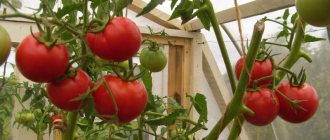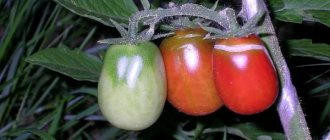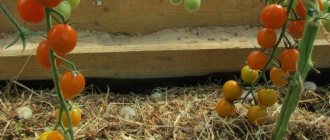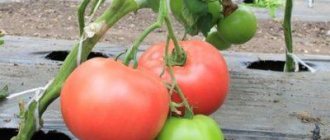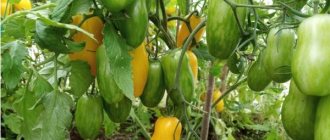History of variety development
Russian agro is well known to vegetable growers - this company is engaged in the development of new varieties of vegetable crops, as well as the distribution of seed material of the developed varieties.
Cherry tomato Cranberry in sugar was created by breeders from this company - M. N. Gulkin, V. G. Kachainik and N. V. Nastenko at the beginning of this century. Varietal testing of the Cranberry tomato in sugar was carried out for several years, and only in 2012 it was included in the Russian State Register.
Photo of cherry tomato Cranberry in sugar
This tomato is recommended for growing everywhere in Russia, including in greenhouses and even on window sills in apartments.
On a note!
Since these tomatoes have a wonderful decorative appearance, many people grow Cranberries in sugar not for the sake of the fruit, but as a decorative houseplant.
Growing on the balcony
If you cultivate the variety in apartment conditions, then each bush should be planted in a container of at least 6 liters. It should be borne in mind that growing in a pot is a more troublesome task. Houseplants are more susceptible to diseases and other ailments. They need to be fed more often and the watering regime must be observed. Care and constant attention are the key to successfully growing tomatoes in an apartment. Tomatoes respond very well to excessive attention and produce good yields.
Tomato Cranberry in sugar: description of the variety
Cherry tomato Cranberry in sugar is classified as an early ripening variety
– from the moment of seed germination to the harvesting of small fruits, 45-50 days pass.
This tomato variety is a low determinate bush, which most often does not need to be formed and tied to strong supports. The height of fairly leafy shoots can reach 0.6 m. After the plant reaches its maximum height, the last bunch of fruits is formed at its top, and the shoot no longer grows.
During the period of intensive fruiting, small red fruits ripen on the clusters.
Tomato bushes Cranberry in sugar are standard type, which are small trees that do not form side stems. Gradually, foliage appears on the plants - small, sparsely spaced, wrinkled, with a characteristic gloss and rare large teeth along the edges, a rich emerald color.
Tomato Cranberry in sugar - video
The bushes form complex racemose inflorescences, each of which can produce up to 6-10 small fruits. The first brush is formed over the fourth or fifth leaf, and each subsequent brush forms after two leaves.
Ripe cherry fruits are small in size, round, similar to cranberries, which is why the variety got its name. The weight of ripe tomato fruits Cranberry in sugar is no more than 15-20 g
. The skin is quite dense, bright red in color, smooth, shiny, and not prone to cracking. It is characteristic that the fruits of this variety are approximately even; after full ripening, even in the area of the stalk there is no green spot left.
The pulp is compacted, tender, with walls of medium thickness; each fruit may have 2 or 3 seed chambers with a small number of seeds.
The taste of ripe tomato fruits Cranberry in sugar is sour, with a small amount of sugar, while a large amount of acid is found in the pulp of the fruit. Many people say that the taste of these fruits is reminiscent of cranberries without sugar.
On a note!
Tasting assessment of the taste of the tomato variety Tomato Cranberry in sugar - 4 points out of 5 possible.
The harvested crop can be transported to any distance; thanks to its thick skin, it can be easily stored in a cool place for at least one and a half weeks.
Official data
Applicant and originator of the variety LLC Agrofirma Aelita, Moscow Russia. The variety was submitted for testing in 2011, and in 2012 it was entered into the register of selection achievements under number 8853426.
Authorship belongs to Nastenko N.V., Kachainik V.G., Gulkin M.N.
The variety is recommended for cultivation in all regional districts of the Russian Federation in open ground and under film covers on the personal farms of gardeners and summer residents.
Diseases and pests
The description of this variety from the manufacturer does not indicate the resistance of this variety to diseases and pest attacks. But reviews from vegetable growers who have been growing the Cranberry tomato variety in sugar for several seasons speak of its high resistance to most diseases that affect other vegetable plants from the nightshade family.
Particularly noteworthy is the variety's resistance to late blight - Cranberries in sugar are not affected by this disease, even if all the tomatoes nearby are severely affected.
There is a great tool:
iodine from late blight of tomatoes
Harvesting and application
Ripe cranberry fruits in sugar remain firm for a long time and do not overripe. They are removed selectively, giving preference to brightly colored ones. Ripe fruits can be stored in the refrigerator for up to 4 weeks. Unripe tomatoes are placed in boxes, sprinkled with dry straw or lined with paper. Cranberry fruits in sugar can last up to 3 months without spoiling, at a temperature of +5 degrees and a humidity of 60%.
Cherries are ideal for canning and pickling. Neat fruits do not become limp, maintaining their density in the jar.
For fresh consumption, the hard shell is removed from the tomatoes. Possessing a pleasant acidity, cherry tomatoes add freshness to salads and are an excellent side dish for meat.
Advantages of the variety
The main advantages of the Cranberry in Sugar tomato variety include:
- early fruit ripening;
- low compact size of tomato bushes;
- these plants do not require regular removal of the shoots, and the shoots do not need to be tied up even during the period of massive fruit ripening;
- the possibility of growing this tomato not only in garden beds and greenhouses, but also indoors - on window sills or glazed loggias;
- high resistance to diseases and sudden changes in weather conditions.
Among the disadvantages of tomato Cranberry in sugar, it should be noted:
- low yield (compared to large-fruited varieties);
- a large amount of acid in the fruits.
Varietal characteristics
Sugared cranberries are an early ripening plant that begins to bear fruit approximately 100 days after planting (80 days after seed germination).
If you follow the care instructions, Cranberries in sugar planted in open ground ripen in early June, and the fruiting period ends only in mid-September.
In a greenhouse with 1 sq. m., about 3 kg of tomatoes are harvested; in open ground, the yield of the variety may be less. Such indicators are considered high among other varieties of cherry tomatoes, but at the same time they are significantly inferior to other, larger varieties. They increase productivity by regularly fertilizing and following watering recommendations.
The Cranberry in Sugar variety is resistant to adverse weather conditions and can be grown in any climatic region. Gardeners also note high resistance to late blight and fungal diseases.
Pros and cons of the variety
| Advantages | Flaws |
| 1. Bright and juicy taste. 2. Thick peel, due to which tomato fruits are used for pickling and salting. 3. Variety of growing methods. 4. High resistance of Cranberries in sugar to late blight and fungal attack. 5. The variety is unpretentious in terms of climatic conditions and is resistant to weather changes. 6. Compact size of the bush, the growth of which is naturally limited in height. After which the bush develops only in width. 7. The tomato variety does not require garter. Does not require stepsoning. 8. Low calorie content of the fruit, making this variety ideal for dietary nutrition. 9. Low maintenance: even a novice gardener can cope with growing Cranberries in sugar. 10. The plant has an attractive decorative appearance, due to which it can be used to decorate rooms. | 1. Low yields of Cranberries in sugar relative to larger varieties. 2. Notes of sourness in the taste. 3. Thick peel, which is why the fruits may be too tough when eaten fresh. 4. Under ideal greenhouse conditions, a tomato bush can grow up to 1.6 m in length, contrary to manufacturers' claims. 5. Risk of disease with mosaic virus. |
Another advantage of the variety is its rich supply of vitamins and microelements. The main beneficial properties of tomato Cranberry in sugar include:
- lowering cholesterol levels;
- normalization of the cardiovascular system;
- improving the functioning of the gastrointestinal tract.
Agricultural technology for growing cherry tomatoes Cran in sugar
Cranberry tomato seeds in sugar are planted in garden beds only in the southern regions of Russia. You can also grow this tomato with seeds in a room on a windowsill. In other areas, it is necessary to first grow seedlings at home, which after a couple of months are transplanted to a permanent place.
Tomatoes on the windowsill for beginners to grow them - video
Seed preparation
Tomato seed material Cranberry in sugar is planted for seedlings in the second ten days of March in such a way that in the second ten days of May the plants can be transplanted into a greenhouse or open ground.
Purchased seeds do not require preliminary preparation. But those harvested from our own beds need to be disinfected before planting. But first, these seeds are dipped in a salty solution to determine germination. All the seed material that has sunk to the bottom can later be planted in the beds - it is full and will sprout well.
Then the seeds are dipped in a pink solution of potassium permanganate for half an hour to disinfect, then they are washed, dried and soaked to improve germination and germination in a solution of any biogrowth stimulator.
Growing seedlings
To plant seed material, you can purchase a commercial nutrient substrate, or you can prepare it yourself. To do this, mix turf soil, humus and river sand in the following proportions: 2:2:1.
The soil prepared at home is spilled with pink potassium permanganate before being placed in containers.
The height of containers for growing tomato seedlings should be no more than 8 cm. They are filled with prepared soil, leveled and watered.
The seeds are buried several mm into the soil, and the distance between them should be at least 3 cm.
A thin layer of sand is poured on top and watered. The containers are covered with glass on top and placed in a dark, warm place until the first shoots appear. After germination, the glass is removed and the containers are transferred to a bright place for further cultivation.
In the future, it is necessary to water the seedlings regularly so that the soil in the containers is constantly moist. When the seedlings have a pair of permanent leaves, they are picked out in separate cups. A couple of weeks after picking, you can feed the seedlings with nitrogen fertilizer for the first time.
Important!
A couple of weeks before transplanting, the plants need to be hardened off little by little by taking them outside.
Low-growing early tomatoes for windows have sprouted CRANBERRY IN SUGAR - video
Transplanting tomato seedlings to a permanent place
Transplanting tomato seedlings Cranberry in sugar in greenhouse conditions can begin from the second ten days of April, and into open ground - from the second ten days of May.
On one square of area you need to plant no more than 5 bushes of this tomato:
one should be in the center, and the rest should be in the corners. Planting is done in cloudy weather or in the evening.
Picking low-growing early tomatoes into pots CRANBERRY IN SUGAR - video
Planting holes are made no more than 10 cm deep, and a layer of wood ash is placed on their bottom. The plants are transferred into the holes along with a lump of ash, deepening them to the first true leaves, adding soil and compacting them.
At least 2 liters of water are added to each bush, and the soil is then mulched. After planting, tomato bushes are watered daily for a week so that the plants acclimatize faster.
Growing indoors
The characteristics of the variety allow you to get a good harvest in a greenhouse or at home.
In the greenhouse
If tomatoes are planted in a greenhouse, then the soil is first warmed up, since the temperature difference between the ground and air slows down the development of roots. Therefore, the soil is first watered with boiling water and covered with black film.
In the apartment
Tomatoes growing on a balcony or windowsill are more susceptible to disease and require more careful care. Before the buds bloom, the plant needs to be turned once every 3-5 days so that the bush forms evenly.
The ideal location for a home garden is a window on the south, southeast or southwest side. Otherwise, you will have to supplement the lighting with fluorescent or phytolamps, which are placed at a height of 25-30 cm from the top of the plant. It is recommended to artificially extend daylight hours to 14-16 hours.
Important! The volume of a pot or box for one plant is about 6 liters.
When grown at home, flowers require artificial pollination. To do this, the bushes are gently shaken several times throughout the day. Pollen can be transferred from one flower to another with a soft brush or feather.
Water homemade tomatoes with water at room temperature every 3-5 days. Always make sure that the soil does not dry out.
To prevent fungal diseases, the bush is sprayed with a weak solution of potassium permanganate about once every two weeks.
Further care for tomato Cranberry in sugar
In the future, tomato bushes Cranberry in sugar require only regular watering and frequent fertilizing.
Irrigation mode
These plants should be watered in the morning with settled warm water. Before the first buds appear, 5 liters of water are added to each square and watered once every 6-8 days. After the flowers appear and during the period of fruit ripening, the volume of watering is increased to 1-1.5 buckets of water. After each watering, you need to loosen the root zone to remove dry crust on the soil surface.
Fertilizer application
In total, during the growing period of this tomato, at least 3 fertilizing should be applied.
12-14 days after transplanting the seedlings, a solution of ammonium nitrate is added to the beds - 40 g of the drug is dissolved in 10 liters of water, 1 liter of the drug is poured under each bush.
3 weeks after the first feeding, you can apply the next one. To do this, 40 g of superphosphate is diluted in a bucket of water and 500 ml of such a nutrient solution is poured under each bush. After two weeks, a similar feeding of the tomato Cranberry in sugar can be repeated.
Rules for planting and care
In open ground, sugared cranberry seeds are planted exclusively in areas with a warm climate. Planting the variety through seedlings is more common.
Sowing seeds for seedlings
Planting of seeds begins in mid-March. To increase germination, they must be soaked for 12 hours in a solution with a biostimulator.
The floating seeds are thrown away: they are empty and therefore cannot sprout.
Tomato seedlings of this variety will require nutritious and loose soil. Substrate preparation:
- 2 parts of turf;
- 2 parts humus;
- 1 part river sand.
Advice! In order to prevent tomato diseases, add 10 g of activated carbon per 1 liter of soil.
Seed planting order:
- Take containers 6-8 cm deep, thoroughly disinfect them and fill them with prepared soil. Sterilize the soil in a convenient way: by freezing or using steam treatment. Level and lightly water the soil.
- Make depressions 2 - 3 mm and plant seeds in them at intervals of 4 - 5 cm.
- Form a thin layer of peat or sand on top. Spray with settled water from a spray bottle.
- Cover the containers with cling film and put them in a dark place. The temperature should be 24 - 27 degrees.
- To prevent condensation from accumulating, the film must be removed once a day for 10 - 15 minutes. The soil should always be moist.
- After the Cranberry sprouts in sugar sprout, you need to place the containers in a bright, warm place: window sills on the south side are perfect.
- After the formation of two pairs of leaves, the tomatoes should be carefully planted in separate containers.
- After 4 days, it is recommended to fertilize with any universal fertilizer. Watering 1 - 2 times a week.
Transplanting seedlings
Planting seedlings of the Cranberry variety in sugar in open ground begins in mid-May. In greenhouses - from mid-April. The main thing is that at least 60 days have passed since planting.
Advice! 15 days before planting, the tomatoes are “hardened” by gradually exposing them to fresh air during the day. It is important that the temperature does not fall below 15 oC.
Delays in planting can negatively affect the plant, slow down its growth and reduce yield. The height of seedlings for this variety should not exceed 35 cm.
For 1 sq. m. with an interval of at least 30 cm, 5 plants are planted: one in the center and the rest in the corners. The best time for planting is the evening of a warm, cloudy day. It is recommended to moisten the seedlings 2 - 3 hours before.
How to replant Cranberries in sugar:
- Dig holes 6 - 10 cm deep in the soil. Sprinkle the bottom with a pinch of tree resin.
- The main thing when replanting is to deepen the root collar of the tomato well to the first leaves and compact the soil.
- Drizzle Cranberries in sugar with 2 liters of water per 1 bush, cover with mulch.
- After transplanting, water the tomatoes every day for 4 - 5 days.
- After a week, loosen the space between the rows by 5 cm.
Tomato care
The Cranberry in Sugar variety is easy to care for. Regular watering and feeding are important for the plant.
Water the tomatoes in the morning with warm water. Before the buds form, watering is carried out once a week at the rate of 5 liters of water per 1 square meter. m. During the period of flowering and fruit set, it is recommended to increase the volume of water to 10 - 15 liters.
During the growing season of Cranberries in sugar, 2 - 3 feedings will be useful. The first is carried out 2 weeks after transplantation. You can feed the bushes with ammonium nitrate (2 tablespoons of solution per medium bucket of water).
After 3 weeks from the previous feeding, Cranberries in sugar are fertilized with superphosphate (2 tbsp per bucket of water). Each tomato bush should be watered with 0.5 liters of solution.
Important! The height of greenhouse shrubs under ideal conditions can reach 1.6 m. In this case, the plant must be tied up and pinched.
Tomato Cranberry in sugar: reviews from those who grow the variety
Larisa, 40 years old, Ryazan: I read in the descriptions that the tomato variety Cranberry in Sugar has sour fruits. I tried to plant this variety on my plot. As a result, the fruits turned out to be quite tasty, not too sour. On the plot I grew tomatoes Cranberries in sugar in open ground. I want to try to plant it in the apartment in winter so that I can collect fresh fruits from the bushes in winter. They say that the Cranberry tomato in sugar grows well on the windowsill - I’ll try it.
Lena, 30 years old, Moscow region: I grew these tomatoes in beds in the garden and in the greenhouse. I can say that when growing indoors, you need to regularly ventilate the room and thin out the plantings so that the plants do not get sick. The taste of tomato cranberry in sugar - with a strong sourness - is, in general, for amateurs. I didn’t like it very much, but I will continue to grow a few bushes for variety in the future.
Oleg, 50 years old, Cherepovets: Accidentally purchased a package of Cranberry seeds in sugar in a specialized store “for change.” I grew the variety in seedlings and later transplanted it into a greenhouse. The bushes grew under 1.5 m; during the period of fruit ripening there were no noticeable leaves behind them. However, the taste of the tomatoes seemed a little bland to me - even the promised sourness was not there. The entire harvest was used for pickling. But I won’t plant this variety again.
Tomato Cranberry in Sugar is one of the new varieties of cherry tomatoes, which is resistant to sudden temperature fluctuations, can even be grown on windowsills in an apartment, and its small fruits are perfect for canning.
And although this variety has a low yield, as well as a sour taste of the fruit, this cherry tomato is still popular among a certain group of vegetable growers.
Landing
Seeds are sown for seedlings everywhere except in the southern regions. In the south, if you plan to grow a variety on the balcony, as soon as it gets warm, the tomatoes are planted immediately in a pot or box. In the middle zone, the procedure is carried out in March:
- Disinfect the seeds in a solution of potassium permanganate and stimulate the development of sprouts with Epin or Zircon.
- Calcine the prepared substrate from the soil in the oven at no less than +110 degrees;
- Place the grains in grooves up to 2 cm deep.
- Cover with glass or wrap in film and place in a warm corner with good lighting until germination.
- Then set a lower temperature (in the first days - +16, then - +18-22) and provide daylight for 12-13 hours a day (turn on the lamps if necessary).
At stage 2 of true leaves, picking is carried out. They are placed on the bed according to a 25 by 30 cm pattern.
Growing tomatoes
The variety is intended for cultivation both in greenhouses and in open ground. Growing is carried out in the traditional way - through seedlings.
How to prepare seeds?
To awaken the seeds and stimulate their growth, several pre-sowing activities are carried out:
- Sorting. The planting material is poured with a saline solution (1 teaspoon of salt per 200 ml of water) and stirred thoroughly. Floating seeds are subject to rejection.
- Warming up. Three days before planting, the seeds are collected in a bag and placed on the battery.
- Etching. On the eve of planting, the seeds are disinfected with a weak solution of manganese (10 mg of manganese per 50 ml of water).
REFERENCE: A good stimulating effect is provided by bubbling - soaking in oxygen-saturated water. To do this, pour the seeds into a liter jar filled with warm water and install an aquarium compressor there. The procedure is carried out within 12 hours.
Sowing seed material
Seeds are sown in late March - early April. The soil for seedlings should be light and nutritious. The best option would be a mixture of turf, peat and sand.
The seeds are planted 2 cm into the soil, then the surface is leveled and watered. To speed up the “pecking” of seedlings, the container for planting is covered with film.
When growing seedlings, maintain the following temperature regime:
- Before emergence – 23-25* C;
- After germination – 20-21* C.
Picking into separate peat pots is carried out after the formation of the second true leaf. Immediately after transplantation, the plants are fed with complex fertilizers.
Rules for planting seedlings
Planting in a greenhouse is carried out in early-mid May, in open ground - in late May - early June. A handful of humus and peat, as well as a tablespoon of wood ash, are added to the planting holes. It is advisable to immediately hammer a post into the ground for future staking of the plant.
The recommended planting density is 3 bushes per 1 sq.m of soil.
Bush care
Like any variety of tomatoes, Brown Sugar requires constant attention:
- As soon as the stem grows to 50-60 cm, it is tied to a trellis or post.
- Every 3 days, root watering of tomatoes is carried out to a depth of 30 cm. The maximum effect is achieved by a drip irrigation system. In addition to saving up to 50% of water, it provides uniform slow watering, necessary for the best distribution of moisture in the soil.
IMPORTANT: The formation of bushes is done in 1 stem, removing the stepsons and lower leaves. Once every 2-5 days, loosen the soil (in dry weather, just break up the earthen crust; in cool weather, loosen it by 10 cm). Loosening should be combined with weeding
Loosening should be combined with weeding
Once every 2-5 days, loosen the soil (in dry weather, just break up the earthen crust; in cool weather, loosen it by 10 cm). Loosening should be combined with weeding.
Top dressing
During the season, at least 4 feedings are carried out:
- Mullein - to stimulate the growth of tops. Take 500 ml of liquid manure per bucket of water and add a tablespoon of nitrophoska. Apply 0.5 liters of solution to each bush.
- Litter - to restore soil acidity and activate flowering. The principle of preparing the solution is similar to the previous one, only instead of nitrophoska the same amount of superphosphate is added.
- Potassium humate – to replenish soil nutrients and accelerate fruiting. For 10 liters of water add 1 spoon of humate and 1 spoon of nitrophoska. Apply 5 liters per 1 sq.m of soil.
- Superphosphate - saturates the soil with phosphorus, improves the quality of the crop. For every meter of soil, distribute 1 spoon of superphosphate dissolved in 10 liters of liquid.
Features of cultivation
As mentioned earlier, you can even grow these tomatoes on the balcony. Agricultural technology will be the same. Plants are propagated by seedlings. Seeds are sown in March; before planting, it is recommended to soak them in a growth stimulator for 10-12 hours.
Tip: The soil for tomatoes should be light and nutritious. The best option is a mixture of turf soil with humus and a small amount of washed river sand.
The seeds are sown with a slight depth, sprinkled with a layer of peat and sprayed with warm water from a spray bottle. For successful germination it is important to maintain a stable temperature (23-25 degrees).
After the sprouts appear, the containers are placed under fluorescent lamps or in bright sunlight. In the phase of formation of the first true leaves, the seedlings are planted in separate small pots. After transplantation, the seedlings are fed with a complete complex fertilizer.
Planting young plants for permanent residence is possible in early May. The soil is thoroughly loosened, and when planting, superphosphate and wood ash are added to the holes.
The bushes do not require pinching; for better ventilation, you can remove the lower leaves. Watering is moderate; every 2 weeks the plants are fed with an aqueous solution of phosphorus and potassium fertilizers. Mulching will help control weeds.
Read more about how and what to fertilize tomatoes:
- Organic and mineral, ready-made complexes, TOP best.
- For seedlings, when picking, foliar.
- Yeast, iodine, ash, hydrogen peroxide, ammonia, boric acid.
Tomatoes on the windowsill
The dimensions of the bushes of tomatoes of the Cranberry in Sugar variety are such that they can be grown on a loggia or even on a windowsill, planted in flowerpots, pots, boxes. As a rule, at home their height does not exceed 30–50 cm.
Tomato bushes Cranberries in sugar can also perform a decorative function
Tomatoes are a light-loving crop. They are not afraid of even direct sunlight. Before flowering, it is recommended to turn the plant once every 3-5 days so that the bush does not form “one-sided”.
With a lack of light, a significant part of the buds and fruit ovaries fall off. Therefore, to place a “vegetable garden”, the window sill of a window facing south, southeast, southwest is best suited. If this is not possible, additional illumination will be required using fluorescent or phytolamps. They are placed approximately 25–30 cm above the top of the bush at a slight angle. To get the harvest as quickly as possible, daylight hours are extended to 14–16 hours.
Seeds are sown in early summer. Then fruiting occurs at the end of autumn and continues until the New Year. The second option is to plant Cranberries in sugar in November. In this case, the harvest is harvested from the end of March until the beginning of summer.
The compactness of tomato bushes Cranberry in sugar allows you to place them even on the windowsill
Seedlings are grown in the same way as for planting in the ground. Tomatoes are planted in small pots with a diameter of 8–10 cm. Then they are transplanted into containers with a volume of 4–6 liters.
Bushes need fresh air, but they are very afraid of cold drafts, so ventilation is carried out very carefully. Those who have been growing tomatoes on the windowsill for a long time recommend placing a glass of water next to the pots while airing. This will help increase air humidity.
There is no one to pollinate Cranberries in sugar at home, so during flowering the bushes need to be gently shaken several times a day. Or transfer pollen from flower to flower by hand, using a feather or soft brush. It is also recommended to spray the bushes with a solution of boric acid (1 g/l) during flowering. This helps to increase the number of fruits and faster ripening of the crop.
A feather or soft brush is suitable for artificial pollination.
Water tomatoes at home every 3-5 days. It depends on how warm it is outside. The soil should not be allowed to dry out. Use only water that has settled and warmed to room temperature, ideally rain or melt water. They pour it not at the root, but closer to the edges of the pot. When it is absorbed, the soil must be loosened.
If the leaves of tomato bushes curl up a little during the day, especially in the heat, this is not a cause for concern. But when they “rise”, located at a sharper angle than before in relation to the stem, this means that they do not have enough light and/or fresh air or are watered too rarely.
Fertilizers are applied once a week, starting from the formation of the fifth true leaf. In 1 liter of water, 1 g of urea and potassium sulfate and 5 g of simple superphosphate are diluted. The norm for one plant is 0.5 l.
Tomatoes grown at home are more susceptible to the development of fungal diseases. For prevention, they are sprayed with a pale pink solution of potassium permanganate every 1.5–2 weeks and dusted with sifted wood ash or tobacco dust.
Potassium permanganate is one of the most popular disinfectants that effectively destroys pathogenic fungi
The variety Cranberry in Sugar, even at home, is characterized by abundant fruiting, so it is advisable to tie the branches to a support - sticks or pegs. The fruits are picked slightly unripe, their skin is colored reddish-brown. At home, they will quickly ripen, and new brushes will begin to form on the plant.
The main pests that threaten Sugar Cranberries at home are aphids and spider mites. They feed on the sap of the plant, so the parts of the bush affected by them are deformed, gradually turn yellow, dry out and die. In especially severe cases, chemicals are used, but they are used no later than 15–20 days before the start of fruiting.
Aphids are very difficult not to notice. Insects settle on the plant in whole colonies, tightly clinging to the top, underside of young leaves, buds and fruit ovaries. For prevention, tomato bushes are sprayed once a week with infusions of any herbs with a pungent odor, orange peels, onion or garlic pulp, and tobacco crumbs. If there are few aphids, the same products will help cope with the pest, but the frequency of treatments is increased to 2-3 times a day. A pest that has multiplied en masse is fought with the help of general-action insecticides - Mospilan, Inta-Vir, Calypso, Fury. Usually 2-3 sprayings are enough at intervals of 4-6 days.
Aphids are one of the most omnivorous pests that attack plants both in the garden and at home.
Spider mites are quite difficult to see with the naked eye, but thin translucent threads entwining the brushes, buds, and top of the plant are clearly visible. For prevention, bushes are sprayed with infusion of garlic or cyclamen tubers every 7–10 days. If the pest has already appeared, folk remedies will not have any effect. It is necessary to use special preparations - acaricides (Neoron, Sunmite, Vertimek).
Specialized drugs are used to combat spider mites
Video: growing tomatoes on the balcony
Description – brief description
The variety was released in 2011. The authorship belongs to the breeders of Agrofirm Aelita. After successful agrotechnical tests, in 2012 tomatoes were included in the State Register of the Russian Federation.
Sugared cranberries are a decorative early-ripening variety. During the fruiting period, tomato clusters are hung with bright clusters of small red fruits, reminiscent of the berries of the same name. Main characteristics of tomatoes:
- the period from the first shoots to the state of ripeness is 75-80 days;
- the culture forms neat, low-growing, determinate bushes;
- maximum height - 60 cm;
- round cherry tomatoes;
- the skin is quite thick, smooth, with slight ribbing at the stalk;
- the pulp is dense, the taste is sweet and sour;
- the number of cameras is about 2-3.
In open ground conditions, the fruits develop a less dense skin. In greenhouses, tomatoes form a hard skin and are suitable for preservation.
According to ripening time | By type of growth | By type of use | By growing method | Fruit weight in (g) | Yield (kg/m²) |
Tomato reviews
Vegetable growers, who test several varieties every year, shared their opinions and became indignant. It turned out that the companies, when packing the seeds, at some stage made a re-grading and indicating that the standard variety was packed with seeds of a very similar, but tall variety, this caused mistrust. Tall varieties require staking and shaping, which stops vegetable growers.
launched another very similar variety, Ladybug, onto the market. Comparing the “Cranberry in Sugar” tomatoes, the description of the variety, characteristics, yield, everything is not in favor of the “cranberry”. However, in order to have your own opinion, you need to sow and grow and perhaps you will like the sourness.
Feeding
A lack of nutrients has a detrimental effect on the development of seedlings and the future harvest, so 2-3 root feedings during the growing season are very important. The first is carried out shortly after planting in the greenhouse with a solution of 0.5 liters of liquid manure and 30 g of the drug “Nitrophoska” in a bucket of water. After 14 days, a second feeding is performed with a solution of 30 g of potassium sulfate and organic fertilizer “Fertility” in a bucket of water. After another 2 weeks, you should feed the plants with a solution of peat-humic fertilizer or any organic matter. Experts give the same recommendations for growing tomatoes on the balcony, only the amount of fertilizing should be increased to 4-5 times.
Planting seeds for seedlings
As mentioned above, it is possible to get a harvest of Cranberry tomatoes in sugar even in an apartment on the balcony. But regardless of the method of growing tomatoes, agricultural technology will be the same.
The key to a successful harvest is growing seedlings, for which you need to sow seeds in March.
To do this, you first need to prepare a light , but at the same time nutritious soil , which is a mixture of humus, earth and river sand, previously washed.
To get good yields, before sowing, it is recommended to soak the seeds for half a day in a growth stimulator, then sow them in a seedling container with well-moist soil and cover with film. The depth of seed placement is 2 cm.
Cranberry tomato seeds in sugar germinate quickly, 4-6 days after planting, and the optimal temperature for germination is 23-25 degrees .
Tomato seeds Cranberry in sugar
After strong shoots appear, the film is removed, and the seedling containers are placed under bright light or special lamps.
After 2 true leaves appear on the sprouts, the seedlings are transplanted into separate containers . Until the seedlings are planted in a permanent place, you need to feed them 2 times with complex fertilizers.
Appearance of bushes and fruits
The presence of a dense skin does not allow the fruits to crack, so tomatoes are canned, pickled, and pickled. Tomatoes are also used as an addition to various assorted vegetables and consumed fresh.
Sugar cranberry is a low-growing standard variety that forms compact bushes with small potato-type leaves, colored dark green. The seed manufacturer does not provide information about plant height. However, according to reviews from those who have already grown this tomato, the bushes can grow up to 40 cm.
Tomato fruits Cranberry in sugar are covered with dense shiny red skin
Small fruits are formed in complex inflorescences. On average, their weight is 15 g. They are round in shape and red in color. The stalk may have slight ribbing, but it may not exist: this is normal. Inside there is dense pulp of good taste. The number of seed chambers is from 2 to 3 pieces.
Some gardeners grow tomato Cranberry in sugar as a potted crop
Tomato Cranberry in sugar can be grown even in a flowerpot suspended on a balcony or in a well-lit room
Advantages and disadvantages
This type of tomato is very popular among summer residents because it has a number of undoubted advantages:
- Unpretentiousness. Even a gardener who is just taking his first steps in the agricultural field can take care of such plants. The plasticity with which a plant adapts to environmental conditions sometimes surprises even experienced gardeners.
- Versatility. Sugared cranberries are successfully grown even in those regions that are usually classified as “difficult” in terms of the availability of natural conditions for agricultural development.
- Determination, standardness. These facts make caring for a plant bush simpler, because there is no need to form a bush. When the genetically determined maximum height is reached, growth stops. At the top, the formation of a cluster with fruits begins. Subsequently, the growth of the bush continues in width.
- Disease resistance. It is extremely rare that this variety is affected by fungal diseases and late blight.
- Decorative. The undoubted advantage of Cranberry tomatoes in sugar is their visual appeal. During the period of fruit ripening, a bush strewn with bright red tomatoes creates a very impressive impression. You can get a harvest even on the window.
- Excellent taste. Sweet, but with a slight sourness, the fruits are perfect for making sauces and dressings, gravies and preservation. Preservation of shape during conservation is an undoubted advantage of this variety. Eating fresh will leave only pleasant impressions.
Cranberries in sugar also have disadvantages. Reviews contain information that the thick skin may be slightly tough. This is most often felt when tomatoes are eaten fresh. According to some who grow this variety, they do not like the sourness present in the taste of these tomatoes.
Some gardeners express the opinion that the description of the variety does not always correspond to what is stated, because the compactness of the bushes in some cases is not as stated by the manufacturer. Planted in a greenhouse, tomatoes can reach a height of 1.5 meters. All shortcomings are easily compensated by high yield and excellent consumer qualities.
Sources
- https://profermu.com/ogorod/pomidory/sorta-p/klyukva-v-sahare.html
- https://DachaMechty.ru/tomat/semena/klyukva-v-sahare.html
- https://fb.ru/article/137227/tomat-klyukva-v-sahare—otzyivyi-pokupateley-vyiraschivanie-i-uhod-za-sortom-tomatov-klyukva-v-sahare
- https://rusfermer.net/ogorod/plodovye-ovoshhi/tomat-pomidor/rannespelye-sorta/klyukva-v-sahare.html
- https://otomate.ru/kljukva-v-sahare.html
What you need to know about the variety
Description of the variety:
- Brought out by domestic breeders and entered into the State Register of Plants of the Russian Federation. Recommended for planting in open ground, under film shelters, in greenhouses, as well as for home growing.
- Plants are of a determinate type, no more than 60 cm high. The standard trunk is strong, so it does not require garter, the crown is compact, the bush takes up little space. Step-sonning may not be carried out.
- The variety is an early variety, the first harvest is harvested approximately 80 days after the appearance of the first shoots. Fruiting is friendly and long-lasting; tomatoes usually set within 2 months.
- The yield is approximately 2.5 kg per square meter. In greenhouses, the figure may be higher, it all depends on the growing conditions and compliance with agricultural practices.
- The taste is excellent. The option is suitable for fresh consumption, as well as for preparations.
- Tomatoes are transportable and last a long time. Therefore, they are often grown for sale.
- The fruits are round in shape and red when ripe. Average weight is 15 grams.
The fruits are small and ripen in whole clusters
Features of agricultural technology
The recommended option for growing early-ripening tomatoes in northern climate zones is the seedling method. Summer residents in the southern regions can plant tomatoes directly in uncovered soil. Nuances of agrotechnical measures:
- Prepare nutritious soil (mix equal parts of compost, humus, river sand).
- The optimal sowing period is the end of March.
- The seed placement depth is about 2 cm.
- Favorable germination temperature is 25-26° C.
- At the stage of 2 true leaves, separate containers are needed for seedlings.
- Planting in unprotected soil is carried out at the age of 60-65 days. The seedlings are first hardened off.
- The distance between seedlings is 25-30 cm.
Nuances of care:
- Fertilizing with complex fertilizers.
- Watering is moderate, preferably with warm water.
- Removing the lower leaves to promote better ventilation of the plantings.
- Spraying with a solution of boric acid will speed up flowering.
Attention! The variety is susceptible to mosaic. If affected bushes appear, they should be burned immediately to prevent the spread of the disease.
Features of care
Tomatoes of any variety have high care requirements. First of all, this concerns watering, which is carried out exclusively with warm water. The most preferable time for watering is the morning. Before the buds appear, moisturizing should be done weekly; during the flowering period, watering should be more generous.
Immunity is good. Damage to dangerous diseases occurs extremely rarely; Cranberries in sugar and late blight with fusarium are not scary. The biggest misfortune that can befall a tomato is mosaic disease. There are currently no treatments for this viral disease, so great attention must be paid to prevention.
To prevent the development of fungal diseases, it is necessary to spray tomatoes with a weak fungicidal solution 2–3 times a season. Well-known copper sulfate and Bordeaux mixture are well suited for these purposes. You can use modern preparations that make it easier to grow tomatoes.
If signs of mosaic disease appear, the bush should be removed from the garden bed as quickly as possible and burned. The disease is spread by insects; a microscopic crack in the leaves or trunks of plants is enough for infection. The virus retains its ability to live for a long time, so the soil must be disinfected after eliminating diseased plants.
The tomato variety Cranberry in Sugar is an excellent option for lovers of exquisite decorativeness and excellent taste. Light sourness and delicate round sweet fruits make the variety indispensable for decorating dishes and giving food exquisite shades of taste. Growing such a tomato is easy.
The “Cranberry in Sugar” tomato is a rather interesting and unusual variety, which, according to its description and characteristics, is distinguished by its aesthetic appearance and tasty fruits. Scarlet tomato bunches stand out beautifully against the background of green ornamental bushes, attracting attention from afar.
